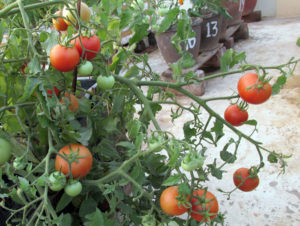
Tomato is one of the most versatile vegetables which is loved all around the world for its flavor, texture, color, taste and juiciness. But tomato is also a food source with an ambiguity. Though botanically its a fruit, it is eaten as a vegetable. However knowing this fact really does not make any difference to you when you want to grow juicy, colorful and yummy tomatoes in a container in your garden. But going through this post on how to grow tomatoes in containers surely will. So without much ado here we go.
Quick Reference Table to Grow Tomatoes in Containers
| Item | Value |
|---|---|
| Growing Temperature | 15 – 30 °C |
| Germination Temperature | 20-30 °C Ideal |
| Germination Time | 3-10 days |
| Soil pH | 5.5 to 6.8 |
| Sunlight Need | 6-8 hours per day (Sun loving Plant) |
| Preferred Planting Method | Transplanting |
| Container size | 15-20 liter |
| Time to Harvest | 60-100 days from germination depending on variety |
| Harvest Period | 3-4 months |
| Pollination | Self pollinating. |
| Typical Pests | leaf eating caterpillar, aphids, fruit borers |
| Typical Diseases | Blossom End Rot, Leaf curl, Septoria leaf Spot, Early Blight, Late Blight |
| Best season to grow in India | November to February. Under shade house you can grow from October – April |
Tomato Varieties you can Plant
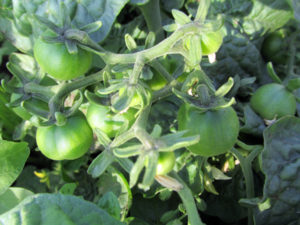
Tomatoes come in many sizes and colors. The smaller tomatoes that are typically not more than an inch on the longest side are called as cherry tomatoes. These come in many colors ranging from red, pink, yellow to purple and are salad friendly vegetables. These are also container friendly varieties and give a huge amount of yield even in small containers.
Tomatoes also can be of bush and vine varieties. The bush varieties which grow to a height of 2-3 feet are called determinate variety and are usually shorter and more compact plants than the vine or indeterminate varieties which grow up to 6-8 feet. As the indeterminate varieties grow much taller more staking is usually needed for these. The major difference however between the determinate and indeterminate varieties is the fruiting cycle. Determinate plants bear fruit in batches. An entire batch fruits and ripens at the same time. And a few days after the first batch has ripened a new batch of flowers start blossoming. In indeterminate variety fruiting, flowering, ripening continues till the season ends all at the same time. However due to size the determinate variety is more suitable for container gardening.
Starting Tomato Seeds and Transplanting in pots
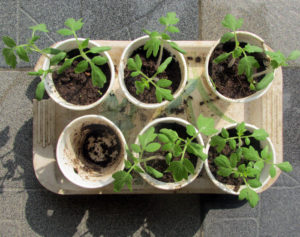
To grow tomatoes in containers you need to start the seeds in a seed tray under controlled conditions as the seedlings take good amount of time to grow. If you do not have a seed tray you can use used paper cups. Fill up the seed tray loosely with seed tray mix (see potting mix post for details) and give a tap so that it settles down nicely in the tray. Spray wet the media so that it settles down further. Drop 3-4 tomato seeds in each cup of the tray. Cover the seeds with more seed tray mix so that the seeds are just covered with 2-3 mm of the mix. Water again very lightly with a water sprayer and keep the tray in a warm place. If the seeds are good and the temperature is right it should germinate within 3-4 days. When seeds have germinated, transfer the tray to a place where the seedlings can get at least 4-6 hours of sunlight.
You need to water the seedlings as needed. Make sure they are protected from direct rain and harsh sunlight. Its better to keep the seedlings under shade house if the daytime temperature is more than 30 degrees. In about twenty to thirty days time when 4-6 true leaves have emerged the sapling is ready to be transplanted.
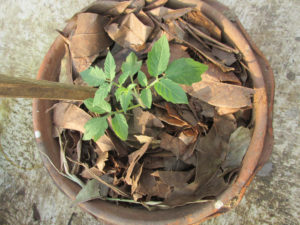
The potting mix that you use for tomatoes must be rich in minerals especially calcium. So be sure to add some fish meal or bone meal to your potting mix when you grow tomatoes in containers. Additionally you can also add crushed egg shells to provide additional enrichment to the soil.
To transplant carefully take out the sapling from seed tray and bury the ball of the sapling it in the center of your pot. Water the pot properly and place it in a sunny area. After about 7-10 days when the saplings have adjusted to the new soil remove the weaker saplings. Retain only one plant and cut off rest of the saplings using a garden scissor. To grow tomatoes in containers successfully you need to limit the number of plants to 1 for 15-20 liter container. If you have much bigger containers you can plant more saplings. But keep at least 1.5 feet distance between each sapling.
Growing Tomatoes in Containers
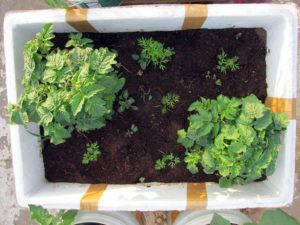
Tomatoes grow very well when they get optimum climatic condition of cooler temperature, low humidity and full sunlight. In case your area is very hot even in winters it will be good to keep tomato plants under a shade house or under shade net. Tomato plants are not strong enough to bear fruits without support. When saplings are planted in a container of appropriate size they grow quite fast and hence staking arrangements need to be done upfront. When you grow tomatoes in containers you can simply stake using a bamboo stick and tie the tomato plant to it using a jute string. You can even stake the tomato plants using a cotton or jute string hanging from any support above the plant. The important thing is to stake your tomato plant well in time to help it grow well.
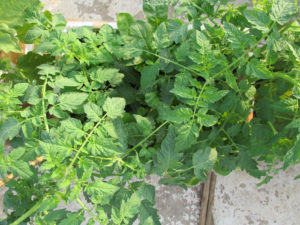
There are a lot of opinion on how to handle the suckers (Suckers are sprouts that develop between the main stalk and a leaf node. They are similar to suckers in eggplant. You can see the picture of a sucker in the post I made on eggplant.) in tomato plants. Some people are of the opinion that, if left on the plant suckers affects the yield and overall health of the plant. While another group of people are against removing the suckers. I follow a middle path approach. I remove the bigger suckers which hinder airflow and penetration of sunlight to all parts of the plant. And rest of the suckers are left untouched on the plant. And this seem to work out fine.
Water your tomato plants as needed. Dry soil can stress your tomato plants. But over watered tomato plant is undesirable. Water the plant at the base and never on leaves. Wet leaves can easily catch fungus. Rain can also cause fungal attack. Hence it is good to provide some protection to the plants during rains so that the leaves do not get wet. When you grow tomatoes in containers it become easy to move them around and protect them from rain. Use a good organic soil conditioner like panchagavya once every 12-15 days to supplement the soil with nutrients. Spraying panchagavya once every 12-15 days also helps in better fruiting and keep away a lot of pests.
Pollinating Tomatoes
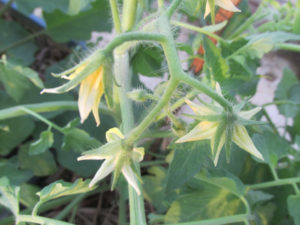
Tomatoes are self pollinating. In lay man’s language every flower of tomato plant is self contained and has the potential to turn into a fruit all by itself. But they need a little help from wind, bees and wasps to get pollinated. So in case you find your tomato flowers are not turning into fruits in spite of the weather being right and plant being healthy you may have to help your plant in pollination. Giving a little shake to the plant helps pollen to fall off from the stamen onto the pistil and thus pollination takes place.
Another way you can hand pollinate tomatoes is by using some kind of vibrating apparatus that mimics the vibration caused by flutter of bees or wasps. A battery operated tooth brush is one such apparatus you can use. Just put on the brush in vibrator mode and move it around near the flowers. Be careful not to touch the flowers. the vibration created in the wind will be sufficient to pollinate the flowers.
Pest Management for Tomato Plants
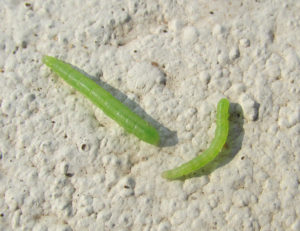
Keep watching for bugs on your tomato plant on a daily basis. Mealybugs are very common on tomato plants and if not checked during initial stages they can infest the plant. Wipe away the bugs as soon as you spot them. You can use a cotton cloth dipped in some methylated spirit to wipe them off. Other major bug family that seem to like tomato plant is caterpillar. Some of them eat up the leaves while others like the winter moth get inside the fruit and eat it up. Cow urine diluted ten times with water can be sprayed to keep the caterpillars away. Panchagavya is also an excellent pest repellent to keep them away. But manually removing them early in the morning everyday works out best.
Harvesting Tomatoes
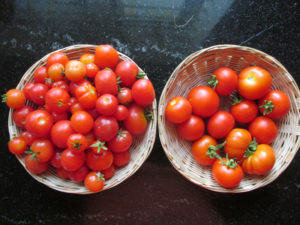
Tomatoes produce a lot of fruits under suitable weather and soil conditions even when you grow them in containers. On the flip side tomatoes are actually very slow growing vegetable compared to most other veggies. They take about sixty days on the plant before you can pick them. A few varieties even take around ninety days to become ripe and mature. So you need to have patience when it comes to harvesting them. Tomatoes in the unripened stage are green and after staying that way for 40-50 days they start to ripen. It is good to pick them up after they have completely ripened and turned red. As soon as they turn red pick them up immediately when they are still firm. You can also pick them up when they are partially ripe and leave them to ripen in your kitchen. When mature, tomatoes can easily be separated from the plant with hand.
Additional Tip
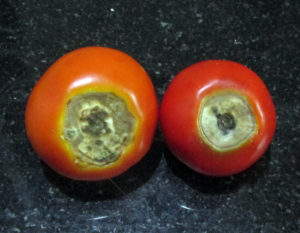
Tomato fruit is susceptible to BER (Blossom End Rot) especially when you grow tomato in containers. The bottom end or blossom end of the fruit is rotted while rest of the fruit looks fine. When this happens you can not consume them. And this happens due to lack of calcium in the soil. As there is limited amount of potting mix in your container, tomato plant may not be able to get the required calcium. To fix this you can water your plant with butter milk with a pinch of asafoetida for a few days. Other quick fix method that you can use to address this problem is to use a herbal calcium tablet. Take one tablet per plant, crush it properly and mix it with half a liter of water. Water your tomato plant with it. This will fix BER issue for a single tomato plant.
And here is the last tip before I sign off. Keep your tomato plants (and plants belonging to tomato family like eggplant) well spread out in the garden. Keeping them together will be conducive for pests (esp caterpillars) to spread to all plants. Keeping them away from each other reduces the probability of pest infestation.


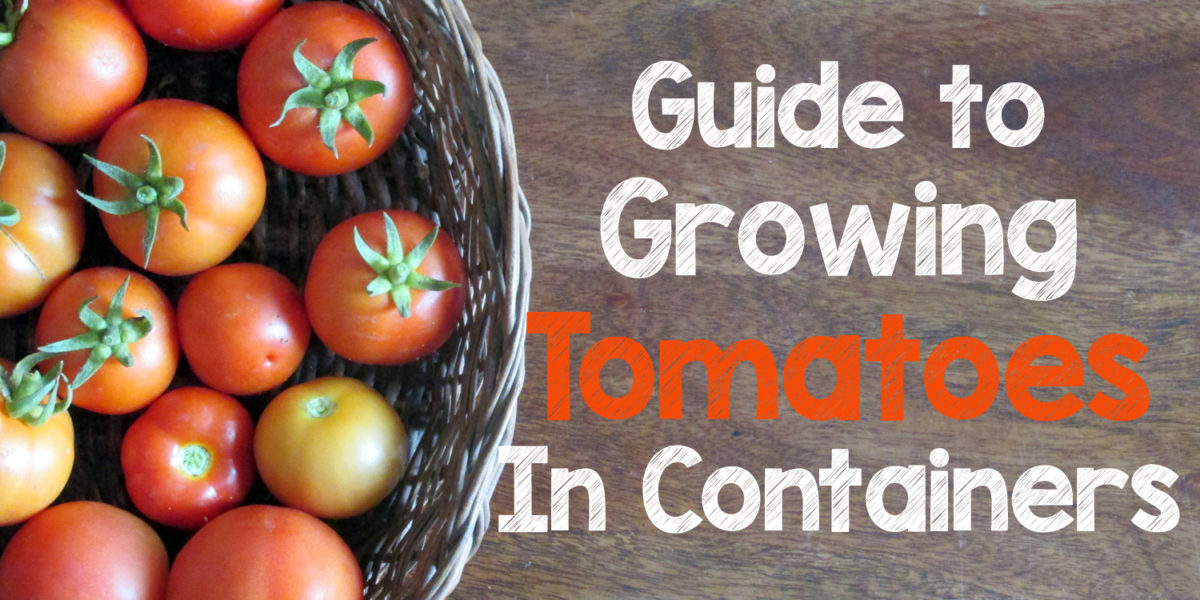
After reading this detailed post even squeamish me is ready to begin. Thank you so much Prabal. Hope I can share some fruit with you.
I’ll look forward to it. 🙂
Followed your instructions to the T and the results were amazing! 13 huge, red tomatoes in one 10 inch container
Awesome.. Good to know this… 🙂